Oregonians lined up outside a credit union for stimulus checks
As I drove by a strip mall last Friday afternoon, I noticed that the parking lot was completely full. I’ve never seen that. I looked past the cars to the stores and saw a line of people running the length of and wrapping around the entire complex. Then it hit me. These people, hundreds of them, were standing in line to enter OnPoint Community Credit Union. The Oregon Legislature had recently decided to use $35 million of federal coronavirus relief funds to provide one-time payments of $500 to qualifying residents. OnPoint was one of the financial institutions that administered the program. Those funds were completely disbursed in three days.
While the stock market has staged a remarkable recovery and reached new all-time highs, tens of millions of Americans are unemployed and facing tremendous financial strain. You’re probably among those who have been able to adapt to the global pandemic without too much discomfort. While many of our clients wouldn’t call themselves wealthy, they are far better off than those who have lost their jobs, had their unemployment benefits reduced and are facing the end of mortgage forbearance or rent abatement.
It might be tempting for those of us who have been largely untouched by the economic fallout of COVID-19 to dismiss the significance of what is happening to the unemployed. We need to remember that the health of our economy relies on consumer spending. If millions of Americans are unable to work, consumption will collapse and our economy will be pulled into a prolonged recession. We also just need to be concerned about our fellow citizens.
The Economy
There continue to be signs that the economy is recovering. Manufacturing and industrial production is improving, but remains well below pre-pandemic levels.
The housing market is very strong. Sales in July were near record-levels. It seems Americans are on the move, as they transition out of rental units and relocate in response to work-from-home (WFH) opportunities provided by their employers. The residential real estate market is hot, with 68% of houses on the market for less than a month.
The Federal Reserve
The Fed continues to express its concern about the strength of the economic recovery. Various members of the Fed have publicly stated over the past several weeks that Congress needs to do more for the economy. The central bank has expanded its balance sheet by $3 trillion, to $7 trillion. However, economic recovery will require continued robust fiscal stimulus.
COVID-19 Numbers
The World Health Organization expects the virus will be under control within two years.
Globally, across 213 countries and territories, there have been over 23 million confirmed cases and over 800,000 deaths. In the US, over 5.7 million have been infected and over 176,000 have died.
We are making progress. The number of positive cases has leveled and begun to decline after a surge in July.
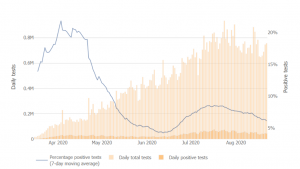
https://coronavirus.jhu.edu/testing/individual-states
Source: Johns Hopkins University
The number of deaths per day remains high, but it not spiking:
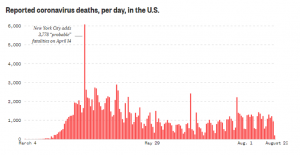
Source: NBC News
The Harvard Global Health Institute provides the heat map below for a more localized view of the threat level.
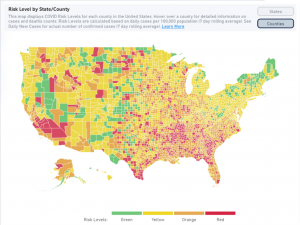
https://globalepidemics.org/key-metrics-for-covid-suppression/
The Markets
On Friday, the Dow Jones Industrial Average was up 191 points, or 0.69%. The S&P 500 Index rose 12 points, or 0.34%. The Nasdaq increased 47 points, or 0.42%. For the week, the Dow was flat, the S&P 500 was up 0.7%, and the Nasdaq rose 2.7%.
The stock market made history this year, twice. The sell-off in March was the most rapid ever. The ensuing recovery was the fastest. Here’s what this looks like.
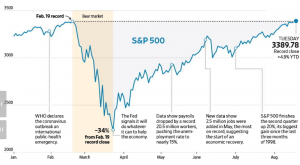
Source: The Wall Street Journal
The yield on the 10-year Treasury Note was down to at 0.636% on Friday.
The Labor Market
The Labor Department reported that another 1.1 million Americans filed for unemployment benefits in the week ending August 15, 2020. This was disappointing, because it was an increase over the prior week and it marked another week with claims in excess of 1 million.
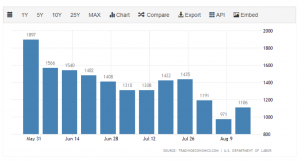
The nation lost 22 million jobs in the months of March and April, but the economy regained 9.3 million jobs over the past three months. This leaves us with an unemployment rate of 10.2%. Recall that the unemployment rate was 3.5% in February, before the pandemic was declared and stay-at-home orders crippled the global economy. There are 28 million Americans receiving unemployment benefits.
No Action on Additional Relief
There has been no progress in Washington toward additional relief funding. The House was called back to the capital to provide additional support for the Postal Service. That legislation passed Saturday and provides $25 billion to address delivery delays and election concerns. However, the Senate is unlikely to pass companion legislation and the President has indicated he does not support the legislation.
Meanwhile funding for unemployment benefits, small businesses, virus testing and contact tracing, educational institutions, and health care providers remains stalled. In response to the impasse, President Trump signed an executive order using $44 billion in disaster relief funds to provide $300 a week in enhanced unemployment benefits. The program is to be administered through the Federal Emergency Management Agency and will require participating states to modify their computer systems to process the disbursements. The President encourage states to match the federal dollars with an additional $100 per week. However, it remains unclear how many states are able and/or willing to do so.
Parting Thought
As we enter the final weeks of summer, the path ahead is uncertain. The economy is healing. But entire industries remain battered. Employment has improved. Yet millions are out of work. Students are returning to school. However, many of them will do remotely. Virus infections are trending down. But we do not know what it will do in the fall.
Keep the faith, be safe and stay healthy.
PLEASE SEE important disclosure information at www.springwaterwealth.com/blog-disclosure/.